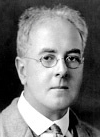Lewis Fry Richardson

Lewis Fry Richardson (1881-1953) was one of the founding fathers of the idea of scaling and fractality, and his life reflects the European geophysical community and its history in many ways. Although many of Richardson's numerous, outstanding scientific contributions to geophysics have been recognised, perhaps his main contribution concerning the importance of scaling and cascades has still not received the attention it deserves.
Richardson was the first not only to suggest numerical integration of the equations of motion of the atmosphere, but also to attempt to do so by hand, during the First World War. This work, as well as a presentation of a broad vision of future developments in the field, appeared in his famous, pioneering book "Weather prediction by numerical processes" (1922). As a consequence of his atmospheric studies, the nondimensional number associated with fluid convective stability has been called the "Richardson number". In addition, his book presents a study of the limitations of numerical integration of these equations, it was in this book that - through a celebrated poem* - that the suggestion that turbulent cascades were the fundamental driving mechanism of the atmosphere was first made. In these cascades, large eddies break up into smaller eddies in a manner which involves no characteristic scales, all the way from the planetary scale down to the viscous scale. This led to the Richardson law of turbulent diffusion (1926) and to the suggestion that particles trajectories might not be describable by smooth curves, but that such trajectories might instead require highly convoluted curves such as the Peano or Weierstrass (fracw) curves for their description. As a founder of the cascade and scaling theories of atmospheric dynamics, he more or less anticipated the Kolmogorov law (1941). He also used scaling ideas to invent the "Richardson dividers method" of successively increasing the resolution of fractal curves and tested out the method on geographical boundaries** (as part of his wartime studies). In the latter work he anticipated recent efforts to study scale invariance in rivers and topography.
His complex life typifies some of the hardships that the European scientific community has had to face. His educational career is unusual: he received a B. A. degree in physics, mathematics, chemistry, biology and zoology at Cambridge University, and he finally obtained his Ph.D. in mathematical psychology at the age of 47 from the University of London. As a conscientious objector he was compelled to quit the United Kingdom Meteorological Office in 1920 when the latter was militarized by integation into the Air Ministry. He subsequently became the head of a physics department and the principal of a college. In 1940, he retired to do research on war, which was published posthumously in book form (Richardson, 1963). This latter work is testimony to the trauma caused by the two World Wars and which led some scientists including Richardson to use their skills in rational attempts to eradicate the source of conflict. Unfortunately, this remains an open field of research.
* "Big whorls have little whorls that feed on their velocity, and little
whorls have srnaller whorls and so on to viscosity- in the molecular sense."
** This idea was already expressed by Perrin (1913) on the now famous
question of the fractality of Brittany.
